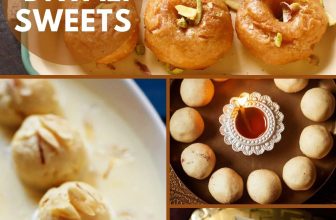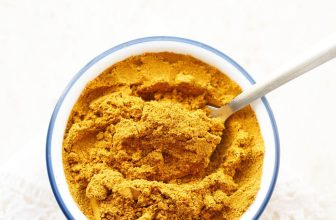
Paneer Angara is a restaurant-style curry made with soft paneer cubes cooked in a creamy onion-tomato-cashew gravy. The flavors are mild and balanced with a touch of warmth from fragrant spices. The curry is finished with a charcoal smoke infusion that gives it a unique depth and restaurant-like flavor. Cashews make the gravy smooth, while cream adds richness and body.
What Makes Paneer Angara Special
Paneer Angara is a rich, creamy North Indian curry made with soft paneer cubes simmered in a smooth onion-tomato-cashew masala base and infused with smoky charcoal flavor.
The word angara means embers or smoke, referring to the traditional method of flavoring the curry with smoke from a hot charcoal.

This restaurant-style Paneer Angara curry has a perfect balance of sweetness from onions, tang from tomatoes, richness from cashews and cream, and gentle heat from red chili powder and whole spices.
The highlight of this dish is the dhungar or smoking step, where a small piece of red-hot charcoal is placed in the curry and covered to trap the smoke. As the curry absorbs it, you get that unmistakable restaurant-style smoky aroma and taste.
Always use natural wood charcoal for this process and never use instant-light or synthetic barbecue charcoal, as they contain chemicals that can affect both the flavor and safety of the food.
I also use the dhungar technique in other recipes like Dal Makhani, Dal Tadka, Baingan Bharta, and Palak Paneer, where the gentle infusion of charcoal smoke gives a deep, earthy flavor.
Adapted from my favorite Paneer Handi, this version has a slightly different base masala and cooking method, but its distinctive flavor comes entirely from the final smoke infusion.
Cashews make the gravy smooth and creamy, while cream adds richness without making it heavy. You can cook Paneer Angara with butter or ghee for a more indulgent flavor, or use oil for a lighter version.
If you like a bit of crunch or color, add lightly sautéed bell peppers (capsicum) before the smoking step. They pair beautifully with the soft Paneer.
In many Indian restaurants, “angara” dishes are known for their smoky flavor and creamy gravies that coat soft paneer or vegetables beautifully.
This Paneer Angara recipe turns out creamy, mildly spiced, and perfectly smoky, just like the ones served in restaurants.
More Restaurant-Style Paneer Dishes To Try
Step-by-Step Guide to Make Paneer Angara
Making Paneer Angara at home is easy once you prepare the base masala well. Follow these detailed step-by-step photos and instructions to get that restaurant-style flavor with a smoky finish.
Make The Masala Paste
1. Heat 2 tablespoons oil or ghee in a pan. Add 2 green cardamoms, 1-inch cinnamon stick, and 2 cloves. Sauté for a few seconds until fragrant.

2. Add 1 cup chopped onions.
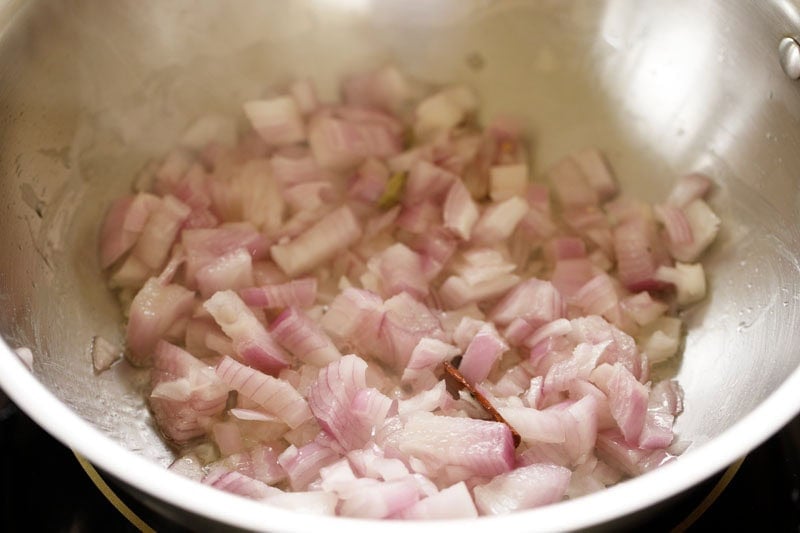
3. Sauté onions on medium-low to medium heat, until they turn translucent and are softened.

4. Add 1 teaspoon chopped ginger and 1 teaspoon chopped garlic. Sauté for a minute.

5. Add 3 tablespoons chopped cashews.
If you prefer, soak cashews in hot water for 20 minutes, then drain water and set aside before adding to the pan.

6. Next add 1 cup chopped tomatoes

7. Sauté for 5 to 6 minutes or until the tomatoes soften. Stir often while sautéing.
Once the tomatoes have turned soft, switch off the heat. Place the pan on countertop and let the sautéed mixture cool slightly.
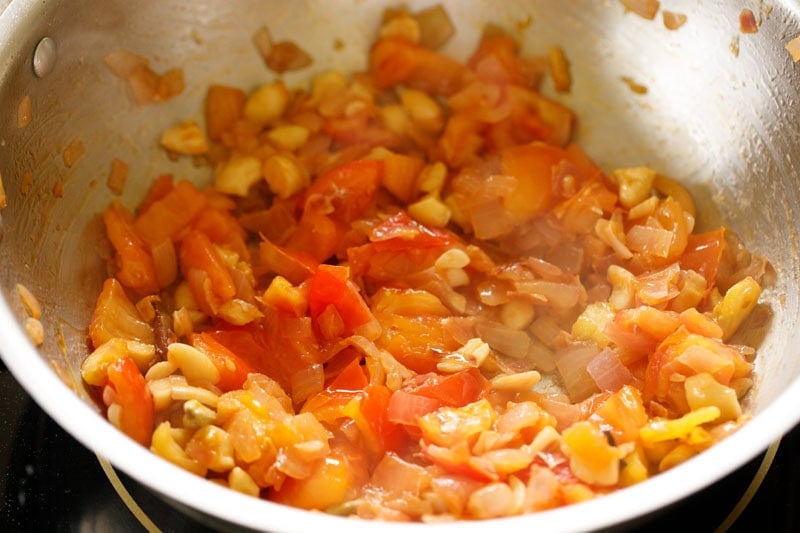
8. Once warm or cooled, transfer to a blender.

9. Add 3 to 4 tablespoons water, or as needed, and blend to a smooth, thick and fine paste. Set this masala paste aside.
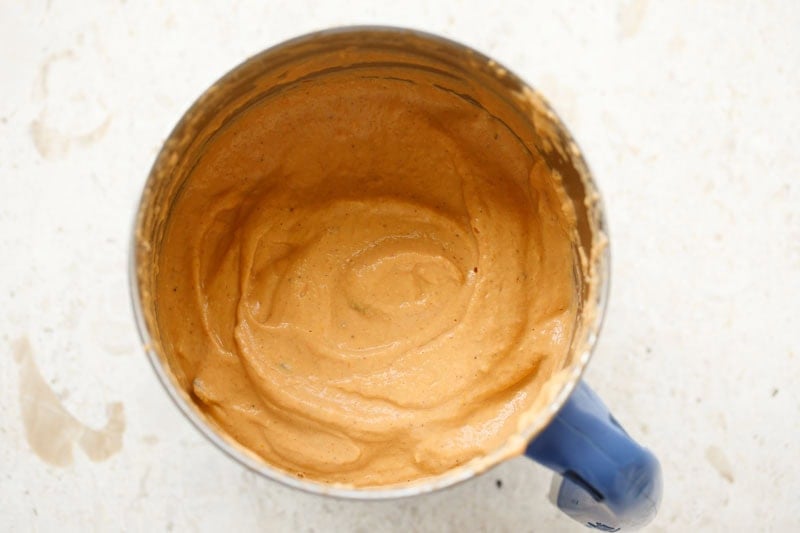
Cook The Gravy
10. In the same or a clean pan, heat lightly 2 tablespoons oil or ghee. Add 1 tej patta (Indian bay leaf) and add the prepared masala paste.
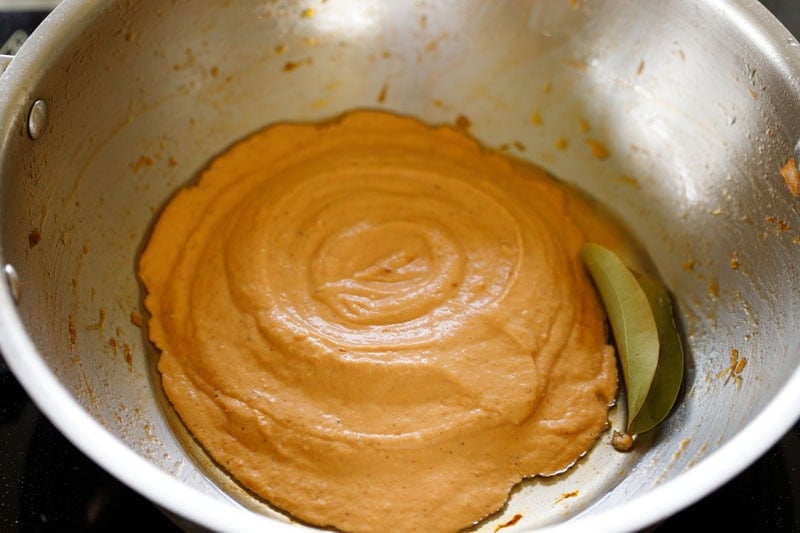
11. Sauté for 6 to 7 minutes on low to medium-low heat till the mixture thickens and looks a bit glossy. Stir often to avoid sticking.
Note: You may not see oil releasing from the sides due to the thickness of the paste. This is because of the cashews.
Tip: Stir the mixture frequently, as it can easily stick to the bottom of the pan. Burnt masala will ruin the flavor.

12. Next add the following ground spices:
- ¼ teaspoon turmeric powder
- 1 teaspoon Kashmiri red chili powder or deghi mirch (I used deghi mirch.)
- 1 teaspoon coriander powder
- ½ teaspoon cumin powder
- ½ teaspoon garam masala or Sabji Masala (I added Sabji Masala)
- salt according to taste

13. Mix well and sauté for a minute.
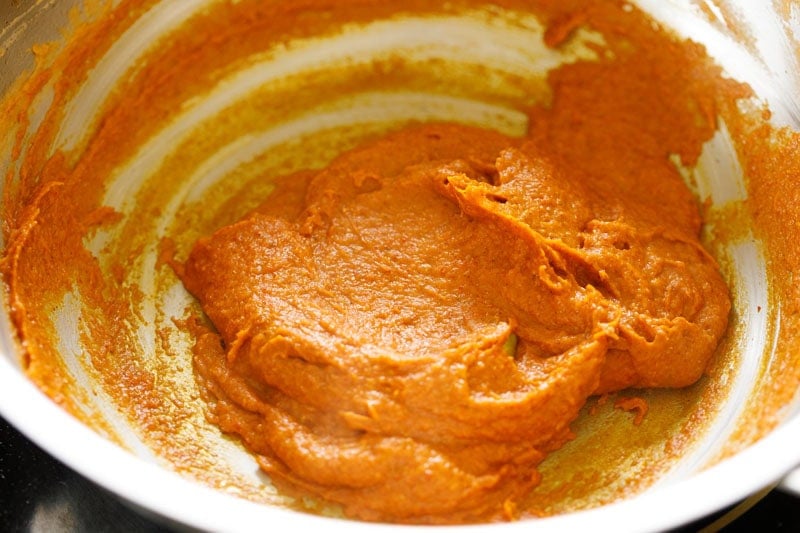
14. Pour in 1¼ cups water. You can vary the amount of water to get your preferred gravy consistency.

15. Whisk gently to make a smooth gravy ensuring there are no lumps.
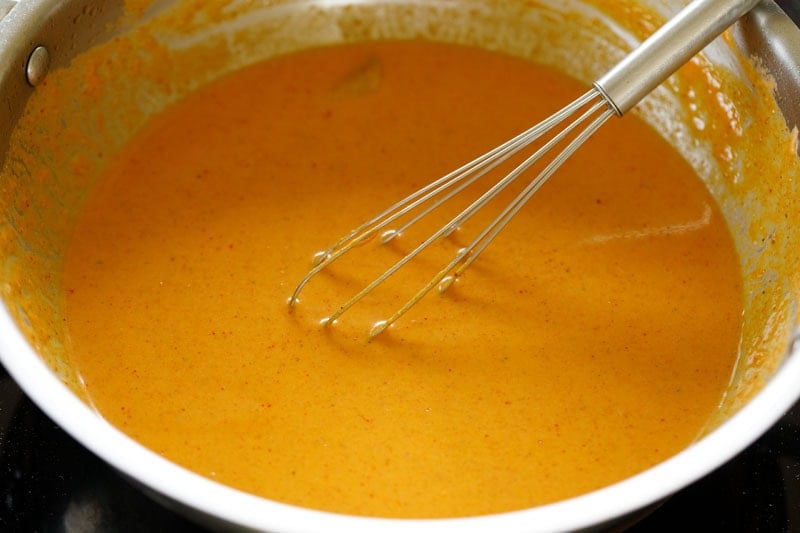
16. Add 1 slit green chilli.

17. Simmer for 6 to 7 minutes on low to medium-low heat, till the flavors blend and the gravy thickens slightly.
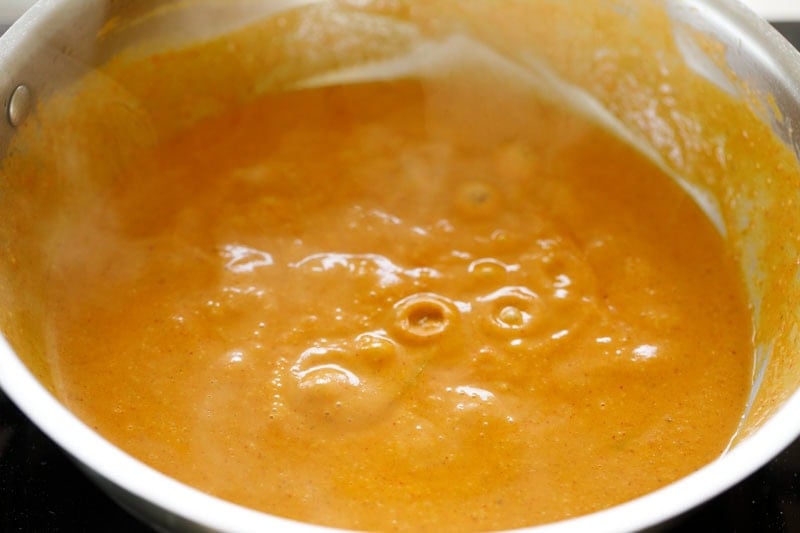
Add Paneer
18. Add 2 tablespoons whipping cream (or heavy cream), 1 teaspoon crushed kasuri methi, and 1 teaspoon sugar (optional). Mix well.
Tip: Add sugar only if needed. Taste the gravy first. If it’s overly tangy or sharp, adding about ½ to 1 teaspoon of sugar will help balance the flavors. Skip sugar if the gravy is already well-rounded or add a few pinches.
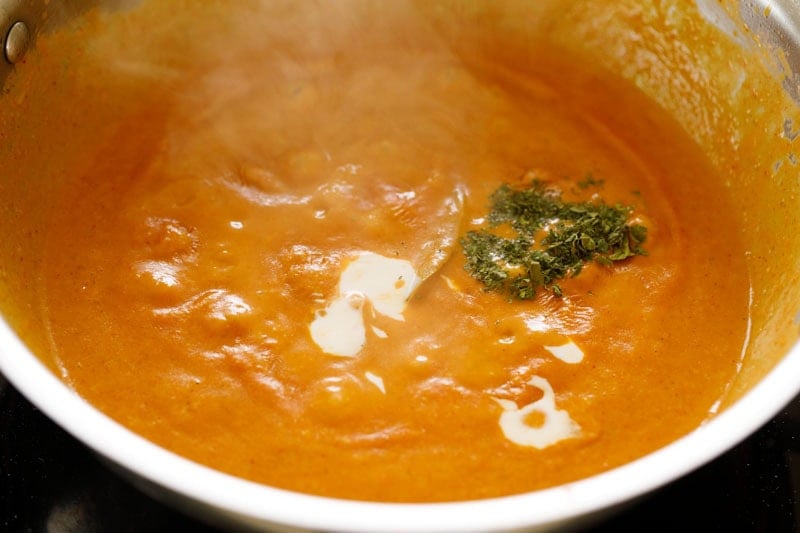
19. Add 200 to 250 grams paneer cubes and 1 to 2 tablespoons chopped coriander leaves.
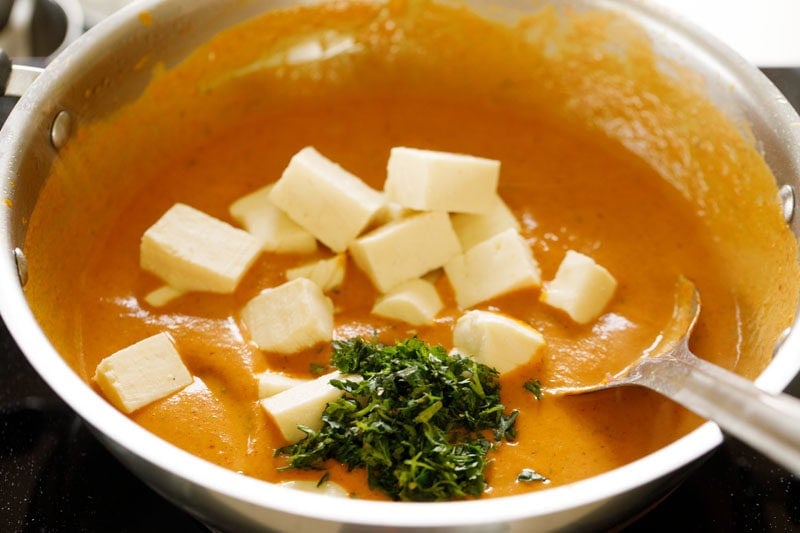
20. Mix gently so paneer stays soft. Turn off heat and cover the pan.
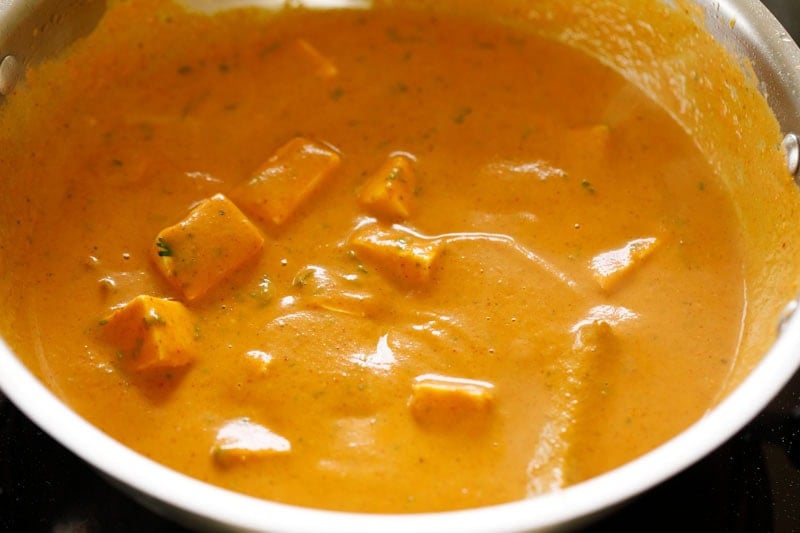
Make Paneer Angara With Dhungar (Smoke Infusion)
21. Place a small steel bowl or thick onion slice in the center of the curry in the pan.
Hold a small piece of natural wood charcoal with metal tongs tightly and place it on a flame-proof metal rack kept over the gas flame. Heat it until it turns red-hot and starts glowing, turning it a few times with the tongs so it heats evenly from all sides.
Note 1: Be careful while heating, as charcoal can sometimes splutter when it gets very hot. Always use tongs when handling hot charcoal and never touch it directly with your hands.
Note 2: Use only untreated, food-safe charcoal made from hardwood or coconut shells. Avoid instant-light, synthetic, compressed, or barbecue briquette types, as they contain additives and chemicals that can affect both flavor and safety.

22. Using tongs, carefully place the hot charcoal in the steel bowl. Pour ½ teaspoon oil or ghee over it. Once the oil is poured, the hot charcoal will start smoking.
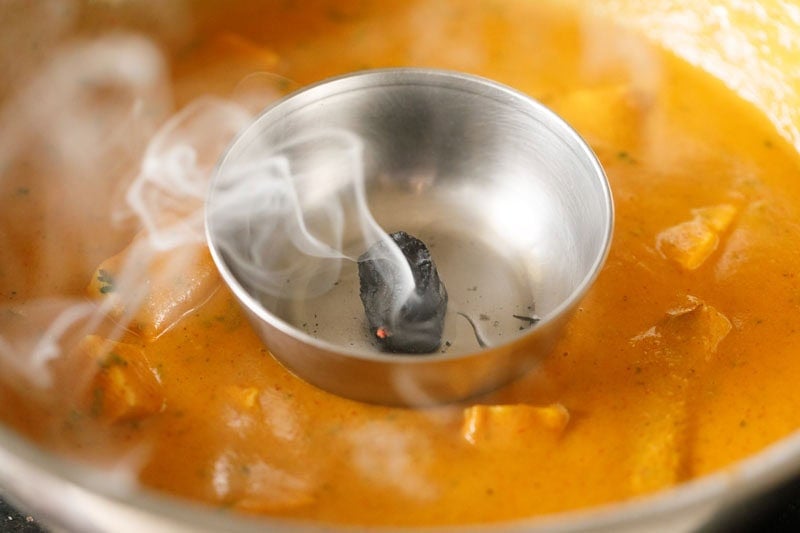
23. Immediately cover the pan with a tight lid. Let it smoke for 4 to 5 minutes so the curry absorbs the aroma.
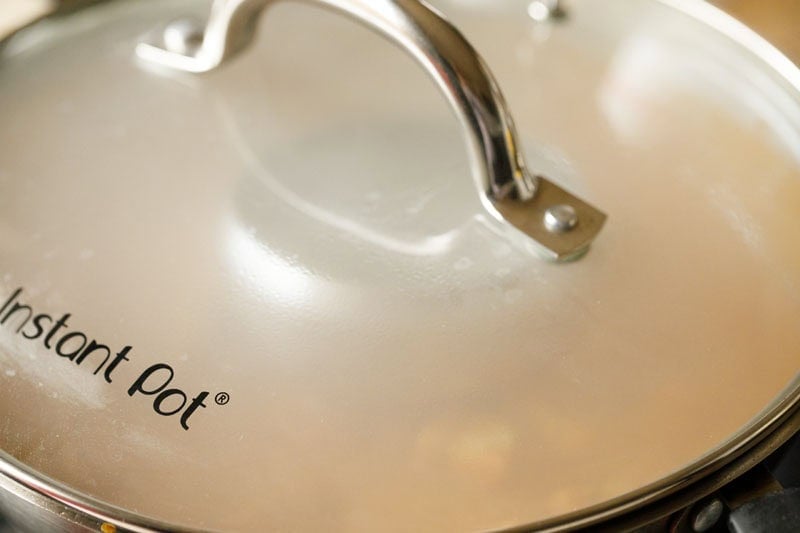
24. Remove the bowl and discard the charcoal.

25. Sprinkle some chopped coriander leaves and drizzle a little cream on top while serving.
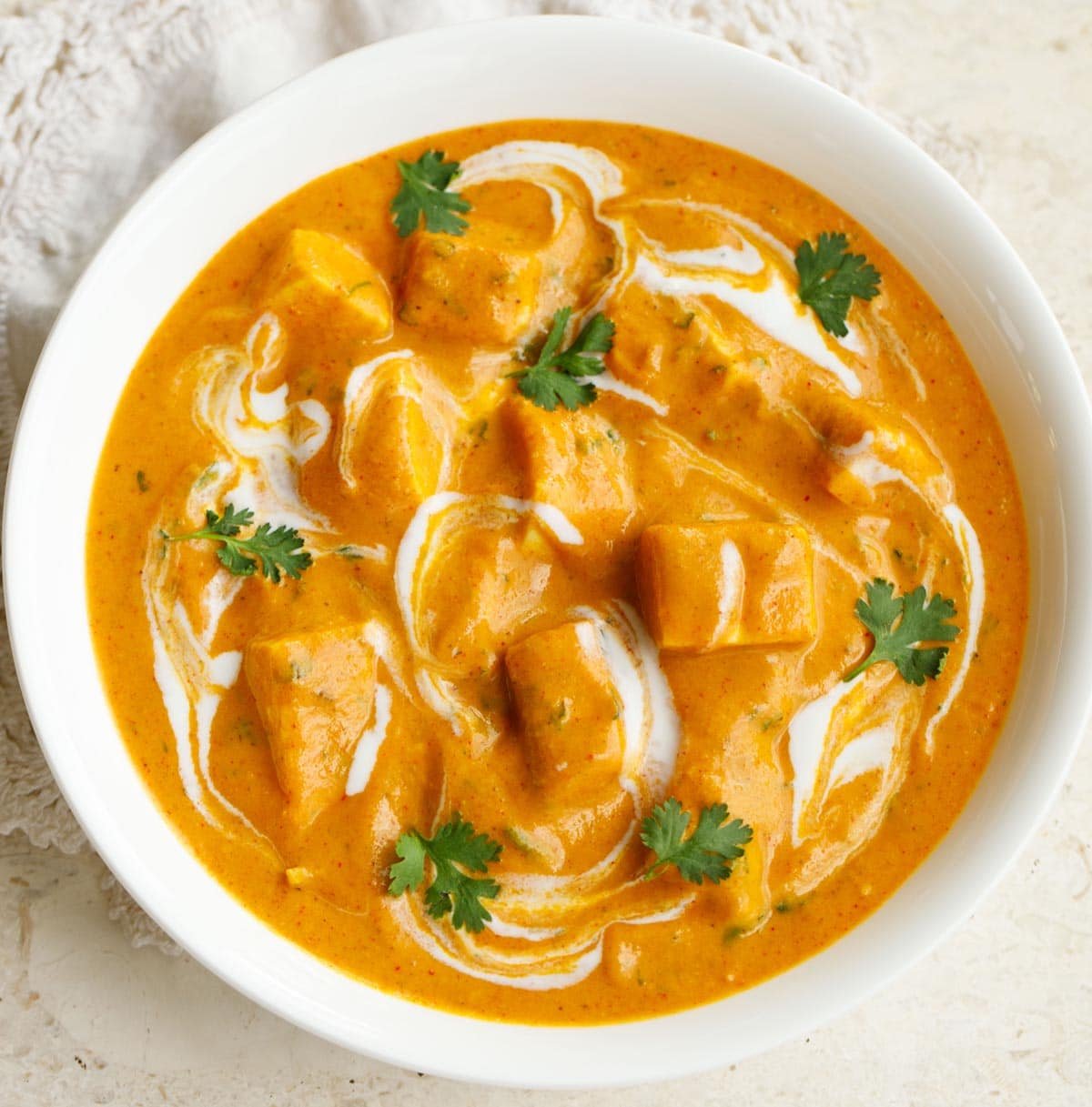
Serving Suggestions
Paneer Angara tastes best when served hot as the smoky flavor is most aromatic right after cooking. Serve it with Naan, Tandoori Roti, Kulcha, Roti or Jeera Rice for a complete North Indian meal.
You can also pair it with plain steamed basmati rice or mild Peas Pulao or Veg Pulao. Add a simple Kachumber Salad or Onion Raita on the side to balance the rich curry. For a festive thali, serve it alongside dal fry, Boondi Raita, and mango or lemon pickle.
Always serve Paneer Angara hot or warm. Once it cools, the gravy thickens because of cashews and cream, so add a splash of warm water while reheating to bring back the right consistency.
Storage Suggestions
Paneer Angara curry stays good in the refrigerator for up to 2 days. Store it in an airtight container after it cools completely.
Reheat on low heat, adding a splash of warm water or milk to loosen the gravy before serving. Avoid freezing, as the paneer texture changes and the smoky aroma fades after thawing.
Dassana’s Cooking Tips
- Paneer: Use soft, fresh paneer. If it’s firm, soak it in warm water for 10 minutes before adding to the curry. You could also use frozen paneer.
- Blending Ingredients: Grind the onion-tomato-cashew mixture to a fine paste for a smooth, creamy gravy.
- Consistency: Add less or more water to adjust consistency. Keep it slightly thick for a restaurant-style feel.
- Including Bell Peppers: For a variation, sauté some cubed capsicum (bell peppers) in a little oil until lightly charred and add them before the dhungar step. It adds color, crunch, and a mild sweetness to the curry.
- Adjusting Tanginess: Add sugar only if the Paneer Angara gravy tastes tangy. Skip it if it’s already balanced.
- Fats: Ghee or butter adds a richer flavor. You can use either in place of oil for both cooking and dhungar.
- Charcoal Dhungar: Do not over-smoke. A light aroma is perfect; too much smoke can make the Paneer Angara gravy taste bitter.
- Frying Paneer: For extra flavor, lightly fry the paneer cubes in a bit of oil or ghee until golden at the edges before adding them to the gravy. This gives a richer taste and prevents them from breaking.
- Making Spicy Gravy: If you prefer a slightly spicier version, use a mix of Kashmiri red chili powder and regular red chili powder instead of only Kashmiri.
Your Questions Answered
What does “Angara” mean in Paneer Angara?
Angara means embers or smoke. The name comes from the smoky flavor infused into the curry using charcoal.
Can I skip the dhungar (smoke) step?
Yes, but the signature flavor will be missing. The curry will still taste good.
Can I use store-bought paneer?
Yes. If using packaged paneer or frozen paneer, soak cubes in warm water for a few minutes to keep them soft.
Can I make it vegan?
Use tofu instead of paneer and replace cream with cashew cream or coconut cream.
How long does it stay fresh?
Paneer Angara keeps well in the fridge for up to 2 days. Reheat gently before serving.
For Dhungar (Smoky Flavor)
Make Onion Tomato Cashew Masala
-
Heat 2 tablespoons oil or ghee in a pan and add cardamoms, cinnamon, and cloves. Fry the spices for a few seconds until fragrant.
-
Add chopped onions and sauté until they soften and turn translucent. Stir in the ginger and garlic and sauté for a minute.
-
Add cashews and chopped tomatoes. Cook until the tomatoes soften well (about 5 to 6 minutes), stirring often.
-
Let the mixture cool slightly, then blend it into a smooth, thick and fine paste in a sturdy blender or mixer-grinder, adding 3 to 4 tablespoons water or as needed.
Make Paneer Angara
-
In the same or a clean pan, heat 2 tablespoons oil and add a tej patta followed by the blended masala paste.
-
Sauté for 6 to 7 minutes on low to medium-low heat, stirring often so it doesn’t stick. The masala paste should look a bit glossy and will also thicken.Note: You wont see any oil releasing from the sides due to the thickness of the paste since cashews are there. Tip: Stir often as the paste has the tendency to stick to the bottom of the pan. You don’t want a burnt masala.
-
Add the turmeric powder, Kashmiri chilli powder, coriander powder, cumin powder, garam masala powder (or sabji masala powder) and salt according to taste.
-
Mix thoroughly and sauté for a minute.
-
Pour in water and whisk gently to get an even mixture without any lumps
-
Add the slit green chilli.
-
Simmer for 6 to 7 minutes on low to medium-low heat, stirring occasionally, until the gravy thickens slightly and the flavors blend.
-
Stir in cream, crushed kasuri methi, and sugar if needed.
-
Add paneer cubes and coriander leaves. Mix gently, turn off the heat, and cover the pan.
Infuse Smoky Flavor (Dhungar)
-
For the dhungar, place a small steel bowl in the centre of the curry.
-
Hold a small piece of natural wood charcoal with metal tongs tightly and place it on a flame proof metal rack over the gas flame. Heat carefully until red-hot, turning it with the tongs so it heats evenly. Note: Use only natural wood or coconut shell charcoal. Avoid synthetic, instant-light, or barbecue briquettes. Be careful when heating, as charcoal can splutter when very hot.
-
Once the charcoal is red-hot, place it carefully in the steel bowl with the help of tongs. Drizzle the oil or ghee over the hot charcoal.
-
Cover the pan immediately, and let the smoke infuse for about 4 to 5 minutes.
-
Remove the bowl and discard the charcoal. Garnish with coriander leaves, and drizzle a little cream before serving Paneer Angara.
Serving Suggestions
-
Serve Paneer Angara hot with naan, butter naan, tandoori roti, or plain paratha for a classic restaurant-style experience.
-
It also pairs wonderfully with jeera rice, saffron rice, or plain basmati rice.
-
Accompany with onion rings, lemon wedges, or a simple cucumber-onion salad for a classic North Indian meal.
Storage
-
Store any leftover Paneer Angara in an airtight container in the refrigerator for up to 2 days. The gravy will thicken, so add a splash of water or milk while reheating.
-
Gently reheat on the stovetop over low heat. Avoid boiling, especially after adding cream.
-
Freezing is not recommended, as the paneer may turn rubbery and the cream based gravy may split upon thawing.
- Paneer: Use soft, fresh paneer for best texture. Soak firm paneer cubes in warm water before adding.
- Blending Ingredients: Blend the onion-tomato-cashew mixture to a fine, smooth paste for a creamy gravy.
- Adjusting Consistency: Add less or more water to adjust the consistency; restaurant-style curries are usually medium-thick.
- Including Sugar: Add sugar only if the curry tastes tangy.
- Note: Always use natural wood or coconut shell charcoal for dhungar. Avoid synthetic or instant-light charcoal as it releases chemical fumes.
- Avoid Over-Smoking: Do not over-smoke. 4 to 5 minutes of charcoal infusion gives enough aroma.
- Optional Fats: Ghee enhances flavor, so use it instead of oil for a richer version.
- More Creaminess: For a more creamier and luxurious curry, add 3 tablespoon of heavy whipping cream.
Calories: 380kcal | Carbohydrates: 13g | Protein: 10g | Fat: 33g | Saturated Fat: 11g | Polyunsaturated Fat: 1g | Monounsaturated Fat: 15g | Cholesterol: 41mg | Sodium: 361mg | Potassium: 246mg | Fiber: 3g | Sugar: 5g | Vitamin A: 582IU | Vitamin B1 (Thiamine): 0.1mg | Vitamin B2 (Riboflavin): 0.05mg | Vitamin B3 (Niacin): 0.5mg | Vitamin B6: 0.1mg | Vitamin B12: 0.01µg | Vitamin C: 10mg | Vitamin D: 0.1µg | Vitamin E: 7mg | Vitamin K: 8µg | Calcium: 280mg | Vitamin B9 (Folate): 16µg | Iron: 1mg | Magnesium: 38mg | Phosphorus: 78mg | Zinc: 1mg





